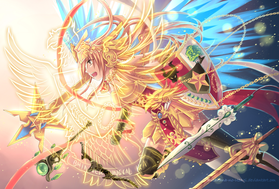Garuda Pancasila
Moegirlpedia would welcome your assistance in improving this article☆Kira~
Improvements can be made in the following areas:
As you read this article, you're welcome to participate in editing this page. Before editing, please read the wiki quickstart, editing guidelines and retrieve relevant information. We wish you a good time on Moegirlpedia. |
 Artwork by ButahananoUsagi | |
| Garuda Pancasila | |
| Name | Garuda Pancasila |
| Other Names | Garuda |
| Origin | Indonesia |
Unity in diversity.
The Garuda Pancasila is the national emblem of Indonesia and one of the national symbols of Indonesia.
Introduction
The Garuda is a golden bird in Indian mythology. Pancasila refers to Indonesia's "Five Principles of National Founding" (the Five Principles of National Founding were originally put forward at the meeting of the "Independent Preparatory Committee" on June 1, 1945. According to the speech, in order to build Indonesia into a country where the whole world is for the public, it must implement five basic principles, namely the five principles of nation-building.
- The first principle is "nationalism", that is, Indonesia is a unified nation-state;
- The second principle is "internationalism". It is not that nationalism and the existence of nation-states are not recognized. This internationalism is based on nationalism;
- The third principle is "consensus", that is, the rights of Muslims are guaranteed through consultations and conferences;
- The fourth principle is "common prosperity", that is, an independent Indonesia should no longer have poverty, and the people of the whole country should be guaranteed a happy life with food and clothing (this requires not only political equality, but also economic practice equality).
- The fifth principle is "belief in Shinto", not only Hide the beliefs of the people, and each Indonesian people should believe in their own Shinto, and all the people must believe in an educated way, without religious prejudice, to make Indonesia a Shinto country.
The Garuda Pancasila was designed by Muhammad Hada. The original version was an anthropomorphic "Garuda", which was later modified to a golden eagle.
| |||||